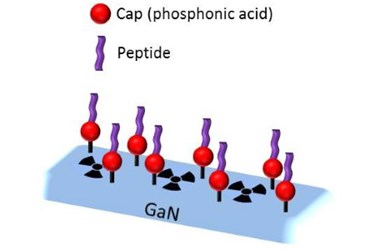New GaN Fabrication Technique Could Enhance Biosensors
By Chuck Seegert, Ph.D.

A recent discovery at North Carolina State University has revealed new ways of binding peptides to the surface of gallium nitride (GaN). The new binding method protects peptides, keeping them stable when exposed to water and radiation, and it could enable new biosensors for medical research applications.
Certain materials like GaN become fluorescent when exposed to radiation. To make use of GaN as a biosensor, the semiconductor is coated with peptides that respond to the presence of certain analytes. When the GaN is subsequently exposed to radiation, these analyte molecules obscure some of the material’s fluorescence. The analyte concentration can then be deduced.
Unfortunately, getting the peptides to reliably bind to the surface of GaN can be quite difficult.
“A key challenge in developing GaN biosensors has been finding a technique to bind the peptides to the GaN surface in a way that keeps the peptides stable when exposed to aqueous environments – like a cell – and to radiation,” said Dr. Albena Ivanisevic, senior author of a paper on the work and an associate professor of materials science and engineering at NC State, according to a recent article from NC State News. “Now we have done that.”
The attachment process is straightforward and performed in an aqueous environment with only mild temperatures, according to a recent study published by the team in Langmuir. The first step is to modify the GaN surface to make it receptive to chemical bonding with other molecules. This is achieved by etching the surface with phosphonic and phosphoric acids, which create a functionalized “cap” on the GaN. Peptides specific to various biological analytes can then be bonded to the active phosphonic acid groups that extend from the cap.
Once the surface had been modified with the desired peptides, the researchers immersed them in an aqueous environment and exposed them to radiation, according to the study. While the surface of the GaN substrate degraded under the high energy delivered, the peptide molecules were still detected.
“The peptides remained on the surface,” said Nora Berg, a Ph.D. student at NC State, in the article. “The aqueous solution caused an oxide layer to form on the surface but there is no indication that this would affect the functionality of the peptides.”
Though it hasn’t been confirmed, the team has a theory about how the oxide layer was developed on the surface of the GaN, according to the study. The hypothesis is that the splitting of water by radiation, or radiolysis, led to reactive oxygen species like hydrogen peroxide. The short-lived molecules then reacted with the substrate material, creating a passivation layer of gallium oxyhydroxide.
Biosensor technologies are thought to hold much promise in the future of medical diagnostics. Because of their sensitivity, they may enable earlier discovery of cancer, as characteristic biomarkers can be detected at very low concentrations. In addition to GaN, other approaches include the use of graphene as a substrate.
Image Credit: Nora Berg
